
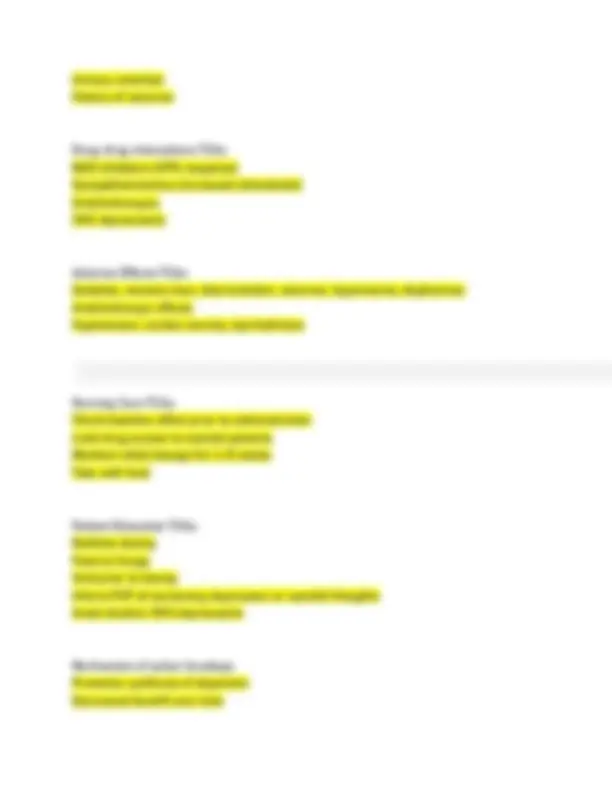
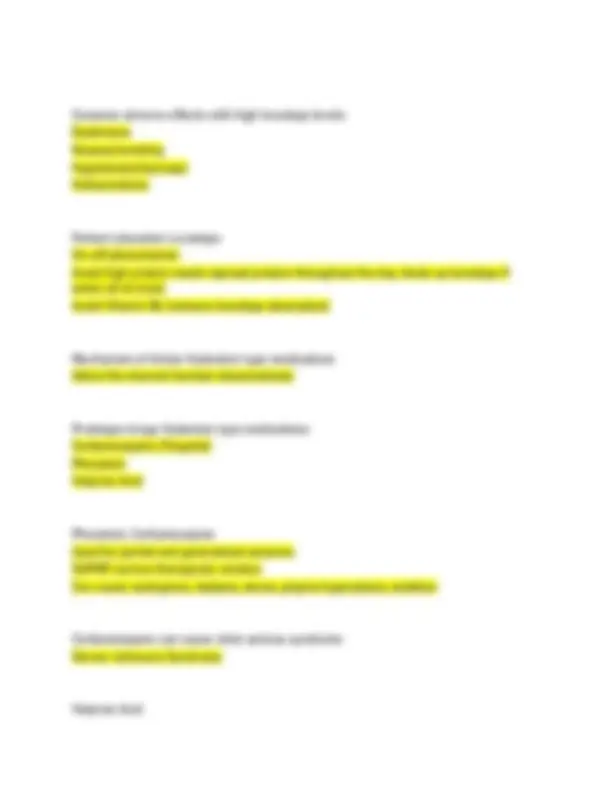
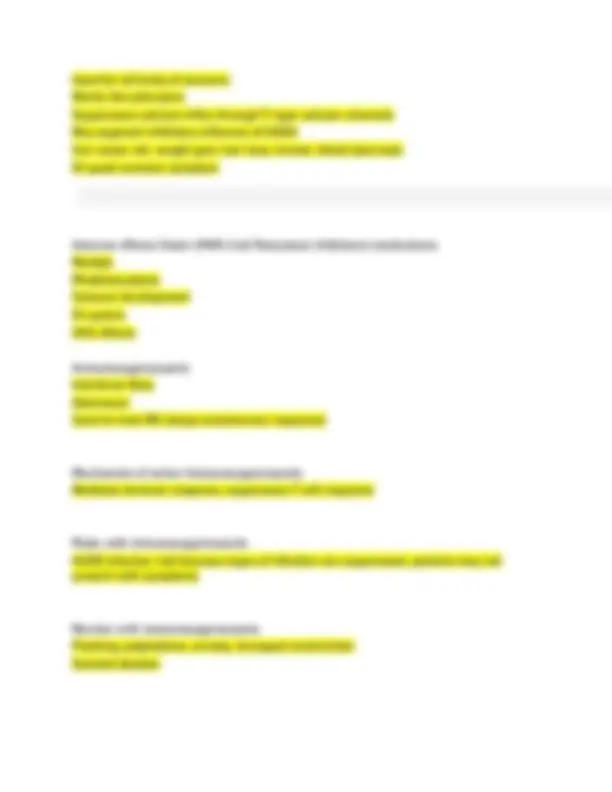
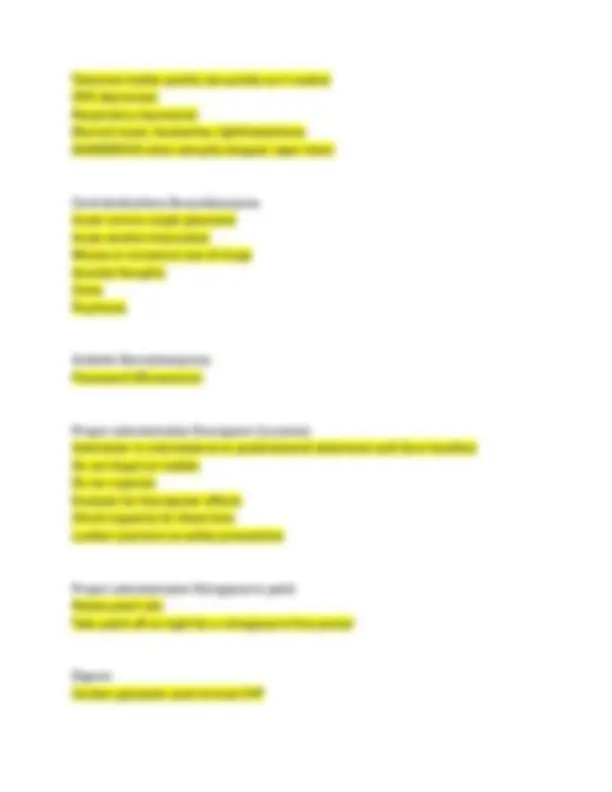
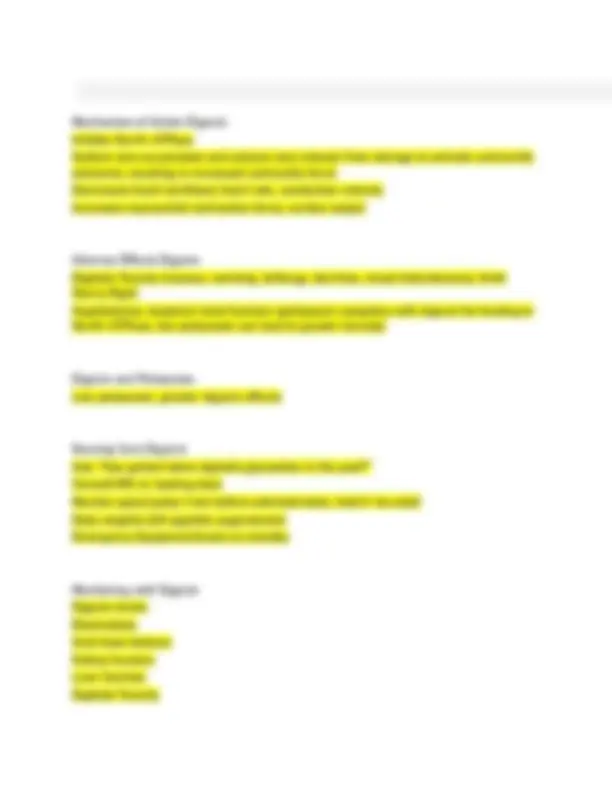
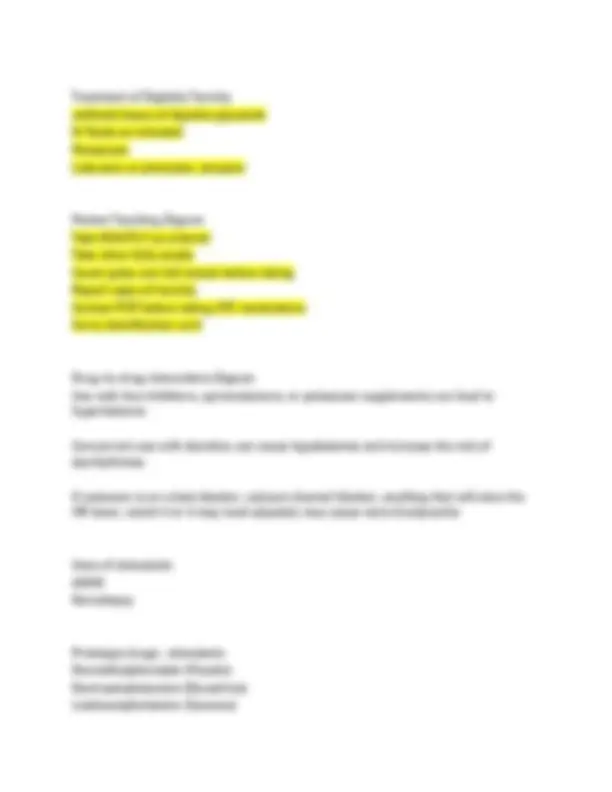
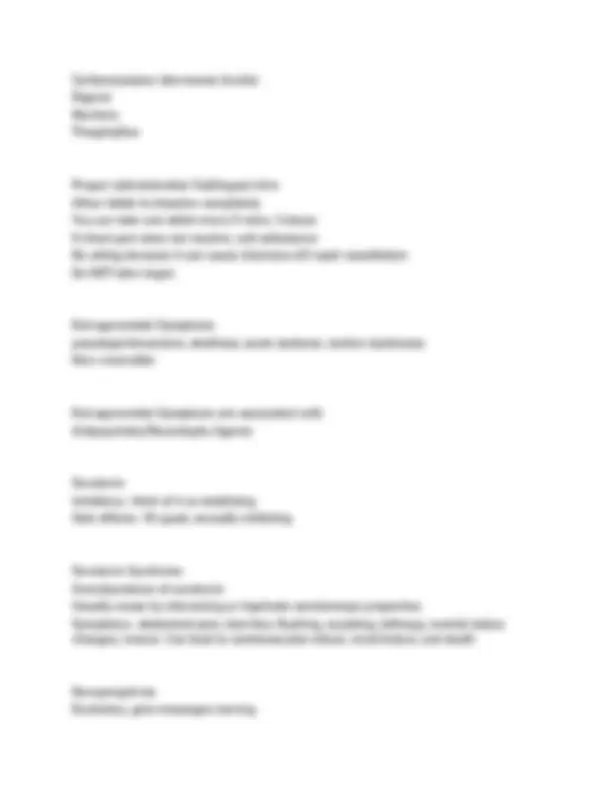
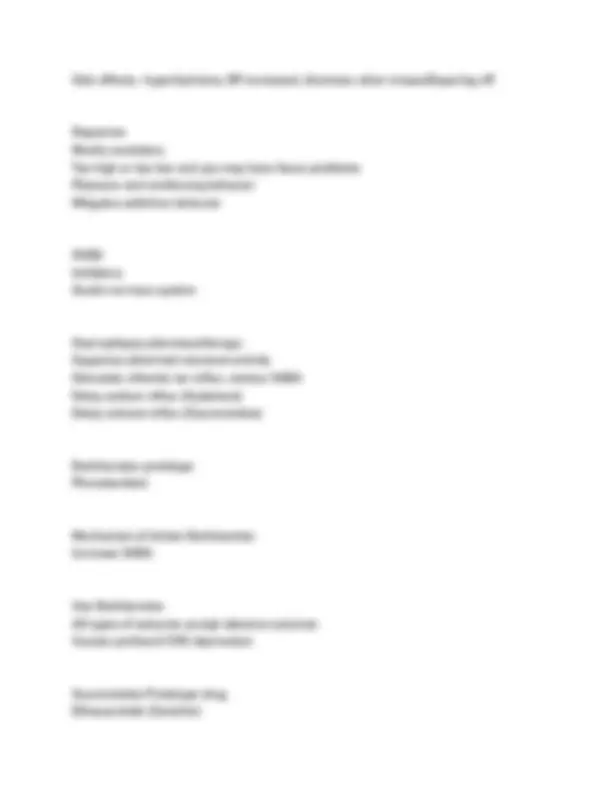
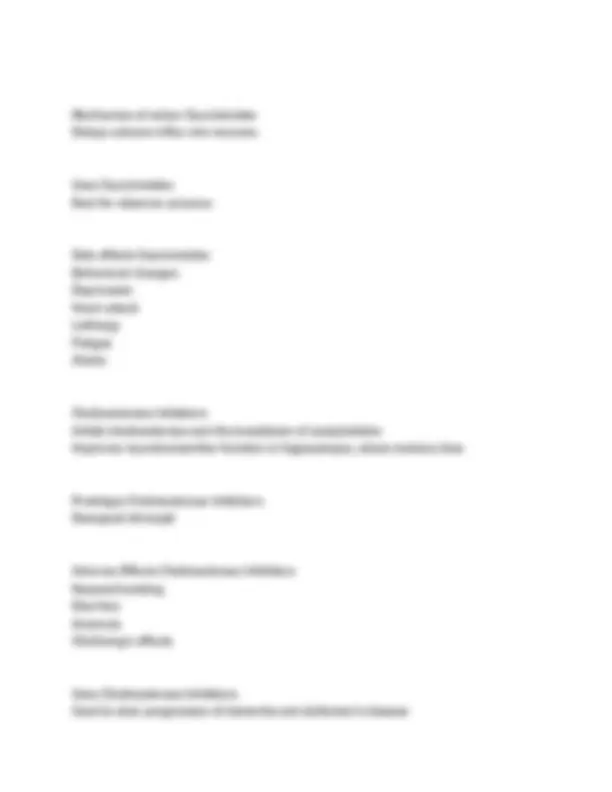
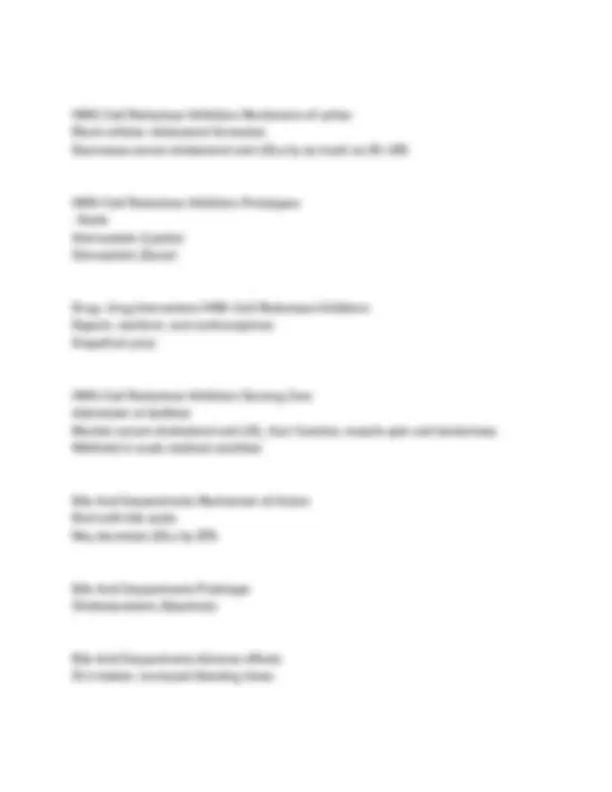
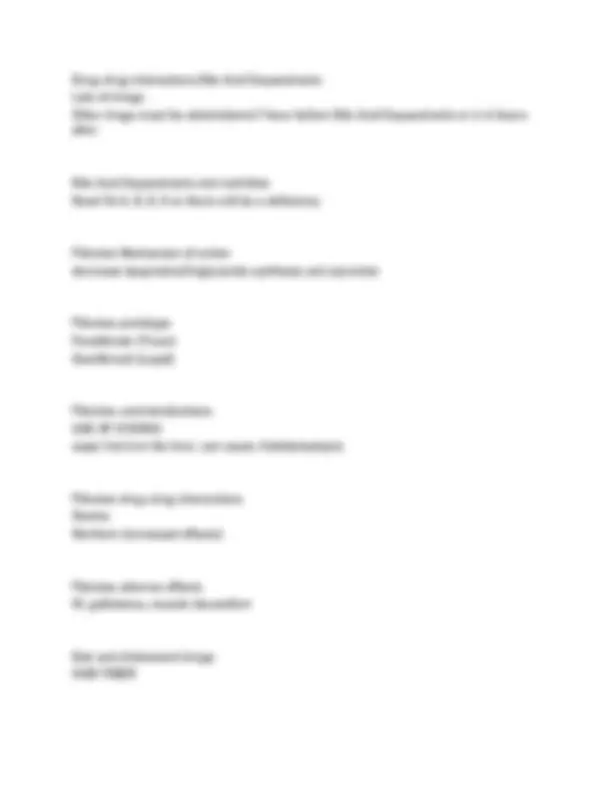
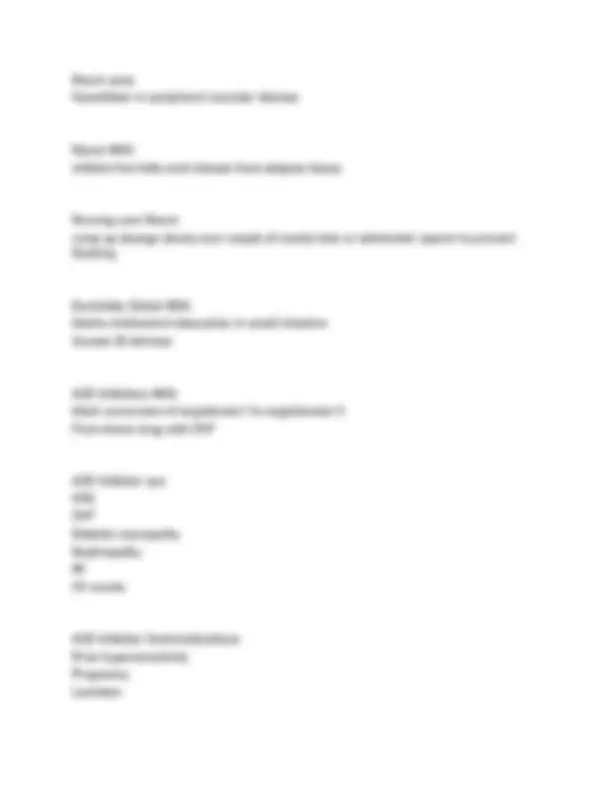
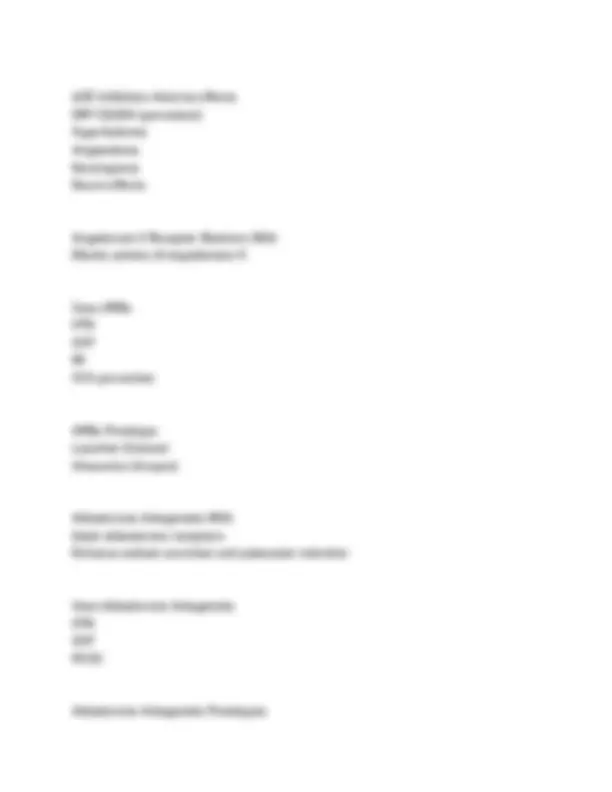
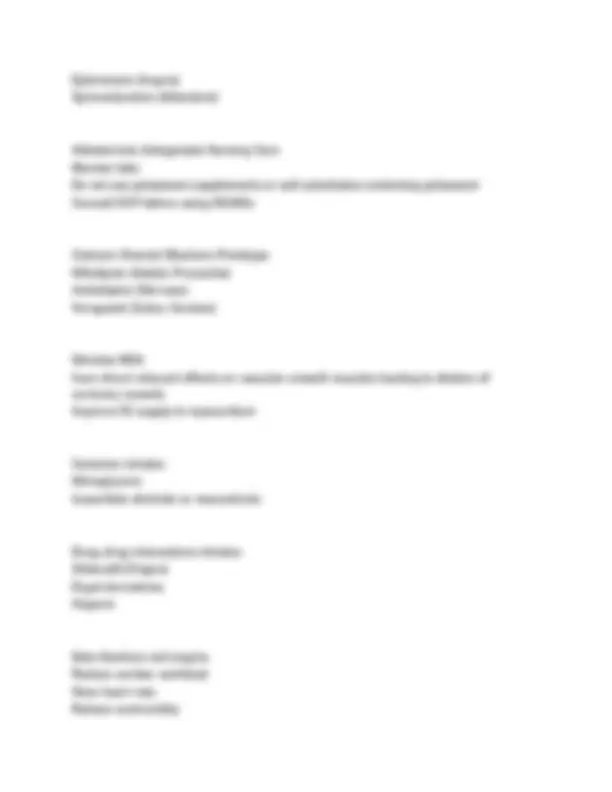
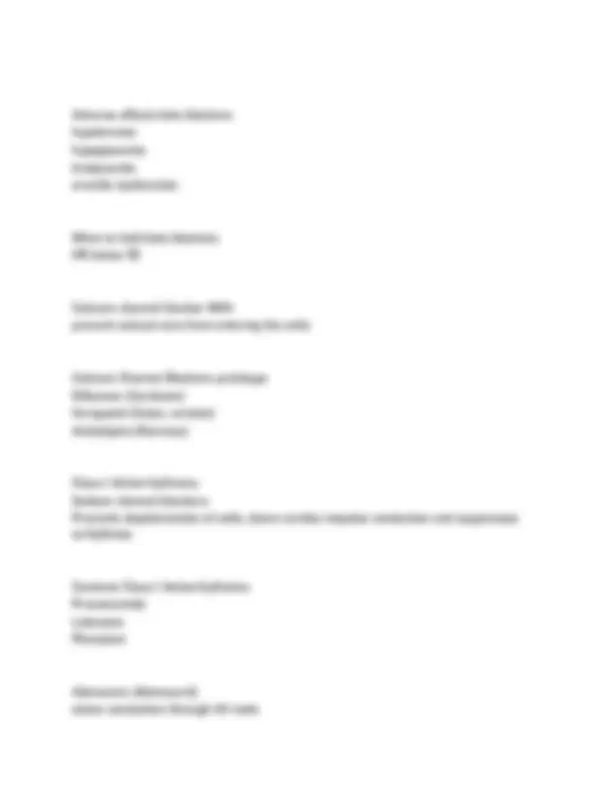
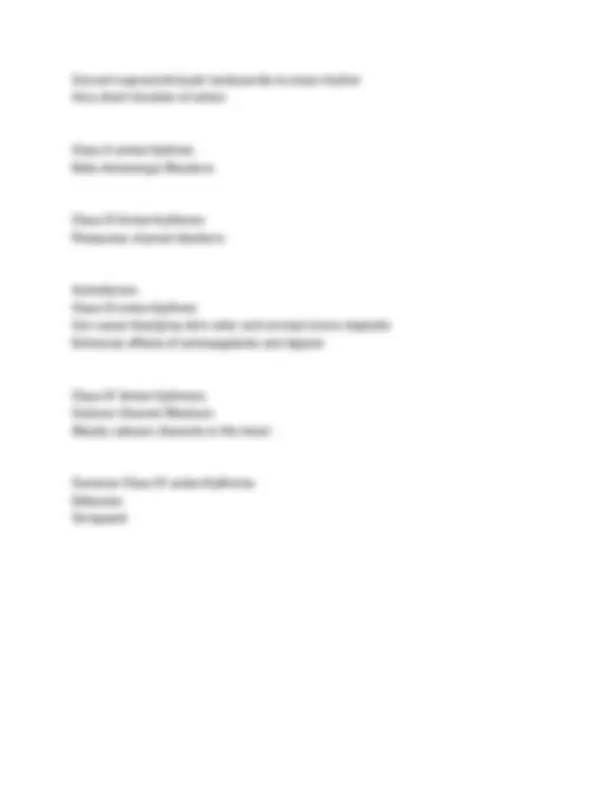


Study with the several resources on Docsity

Earn points by helping other students or get them with a premium plan


Prepare for your exams
Study with the several resources on Docsity

Earn points to download
Earn points by helping other students or get them with a premium plan
Community
Ask the community for help and clear up your study doubts
Discover the best universities in your country according to Docsity users
Free resources
Download our free guides on studying techniques, anxiety management strategies, and thesis advice from Docsity tutors
A comprehensive overview of key concepts in applied pharmacology, focusing on the treatment of parkinson's disease, depression, seizures, and multiple sclerosis. It includes detailed information on various medications, their mechanisms of action, adverse effects, nursing care considerations, and patient education guidelines. The document also covers important lab tests and administration procedures for specific medications.
Typology: Exams
1 / 24

This page cannot be seen from the preview
Don't miss anything!

















Parkinson's Disease Symptoms Tremors at rest Muscle Rigidity Bradykinesia Postural instability Flattened affect Pharmacotherapy Parkinson's Disease Dopaminergic Agents (Levodopa, Carbidopa, Rytary, dopamine Agonists, COMT Inhibitors, MAO-B Inhibitors) Anticholinergic medications Levodopa Cornerstone of Parkinson's Disease treatment Promotes synthesis of dopamine Therapeutic effects may take months Decreased benefits over time Dyskinesias Carbidopa Decreases destruction of dopamine so more can enter the brain Decreases body's tolerance to levodopa Dyskinesias occur sooner and may be more intense
Dopamine Agonists Directly activate dopamine receptors in striatum Pramipexole (Mirapex) Do not require enzymatic conversion, do not convert to toxic metabolites, do not compete with dietary proteins, decreased dyskinesias Disadvantages include somnolence, hypotension, syncope, hallucinations, addictive behavior COMT inhibitors Used with levodopa, inhibit the metabolism of levodopa Entacapone (Comtan) Increases levels of levodopa avilable Causes n/v, diarrhea, constipation, yellow-orange urine, dyskinesias, hallucinations, sleep disturbances, orthostatic hypotension Mechanism of action TCAs Inhibits reuptake of norepinephrine and serotonin into presynaptic nerve terminals Directly blocks histamine, acetylcholine, and norepinephrine receptors Uses TCAs Depression OCD Anxiety/panic attacks Enuresis (bed-wetting) Drug prototype TCAs Imipramine (Tofranil) Contraindications TCAs Recent MI Angle-closure glaucoma
Common adverse effects with high levodopa levels Dyskinesia Nausea/vomiting Hypotension/syncope Hallucinations Patient education Levodopa On-off phenomenon Avoid high protein meals (spread protein throughout the day, binds up levodopa if eaten all at once) Avoid Vitamin B6 (reduces levodopa absorption) Mechanism of Action Hydantoin type medications Alters Na channel function (desensitizes) Prototype drugs Hydantoin type medications Carbamazepine (Tergetol) Phenytoin Valproic Acid Phenytoin, Carbamazepine Used for partial and generalized seizures SUPER narrow therapeutic window Can cause nystagmus, diplopia, ataxia, gingiva hyperplasia, sedation Carbamazepine can cause what serious syndrome Steven Johnsons Syndrome Valproic Acid
Used for all kinds of seizures Works like phenytoin Suppresses calcium influx through T-type calcium channels May augment inhibitory influence of GABA Can cause rah, weight gain, hair loss, tremor, blood dyscrasis GI upset common symptom Adverse effects Statin (HMG-CoA Reductase Inhibitors) medications Myalgia Rhabdomyolysis Cataract development GI system CNS effects Immunosuppressants Interferon Beta Glatiramer Used to treat MS (stops autoimmune response) Mechanism of action Immunosuppressants Mediates immune response, suppresses T cell response Risks with immunosuppressants HUGE infection risk because signs of infection are suppressed, patients may not present with symptoms Monitor with immunosuppressants Flushing, palpitations, anxiety, laryngeal constriction Suicidal ideation
Lab Tests Heparin Check PTT each day prior to administration Therapeutic is 1.5 to 2.5 times control value With low molecular weight heparins, monitor platelet count every 2-3 days throughout therapy Lab Tests Coumadin PT (protime therapeutic level)
Tolerance builds quickly (as quickly as 4 weeks) CNS depression Respiratory depression Blurred vision, headaches, lightheadedness DANGEROUS when abruptly stopped, taper down Contraindications Benzodiazepines Acute narrow-angle glaucoma Acute alcohol intoxication Misuse or excessive use of drugs Suicidal thoughts Coma Psychosis Antidote Benzodiazepines Flumazenil (Romazicon) Proper administration Enoxaparin (Lovenox) Administer in anterolateral or posterolateral abdominal wall (love handles) Do not dispel air bubble Do nor aspirate Evaluate for therapeutic effects Check regularly for blood loss Lumbar puncture as safety precautions Proper administration Nitroglycerin patch Rotate patch site Take patch off at night for a nitroglycerin free period Digoxin Cardiac glycoside used to treat CHF
Treatment of Digitalis Toxicity withhold doses of digitalis glycoside IV fluids as indicated Potassium Lidocaine or phenytoin, atropine Patient Teaching Digoxin Take EXACTLY as ordered Take when fully awake Count pulse one full minute before taking Report signs of toxicity Contact PCP before taking OTC medications Carry identification card Drug-to-drug interactions Digoxin Use with Ace inhibitors, spironolactone, or potassium supplements can lead to hyperkalemia Concurrent use with diuretics can cause hypokalemia and increase the risk of dysrhythmias If someone is on a beta blocker, calcium channel blocker, anything that will slow the HR down, watch it or it may need adjusted, may cause more bradycardia Uses of stimulants ADHD Narcolepsy Prototype drugs- stimulants Dexmethylphenidate (Focalin) Dextroamphetamine (Dexadrine) Lisdexamphetamine (Vyvanse)
Methylphenidate (Ritalin) Modafinil (Provigil) Adverse effects Stimulants Palpitations, HTN, increased HR, dysrhythmias Causes appetite depression Nursing care Stimulants Dispense least amount of drug possible Give before 4-6 pm to reduce insomnia If used for weight loss, give 30-90 minutes before meals If used for other purposes, wait until after meals (appetite suppressant) Monitor weight, height, bone structure CBC, ECG Avoid caffeine and other stimulating drugs Mechanism of Action MAOIs Inhibits monoamine oxidase Increases neurotransmitter availability MAO-A inactivates NE and serotonin MAO-B inactivates dopamine Uses MAOIs Treatment of depression Parkinson's disease Prototype drugs MAOIs Phenelzine (Nardil), Isocarbaxid (Marplan), Tranylcypromine (Parnate) MAO-B Inhibitor Prototypes Selegiline (Eldepryl)
Carbamazepine (decreases levels) Digoxin Warfarin Theophylline Proper administration Sublingual nitro Allow tablet to dissolve completely You can take one tablet every 5 mins, 3 doses If chest pain does not resolve, call ambulance Be sitting because it can cause dizziness d/t rapid vasodilation Do NOT take viagra Extrapyramidal Symptoms pseudoparkinsonism, akathisia, acute dystonia, tardive dyskinesia Non-reversible Extrapyramidal Symptoms are associated with Antipsychotic/Neuroleptic Agents Serotonin Inhibitory- think of it as stabilizing Side effects- GI upset, sexually inhibiting Serotonin Syndrome Overabundance of serotonin Usually cause by interacting or duplicate serotonergic properties Symptoms- abdominal pain, diarrhea, flushing, sweating, lethargy, mental status changes, tremor. Can lead to cardiovascular shock, renal failure, and death Norepinephrine Excitatory, gets messages moving
Side effects- hyperhydrosis, BP increased, dizziness when missed/tapering off Dopamine Mostly excitatory Too high or too low and you may have focus problems Pleasure and reinforcing behavior Mitigates addictive behavior GABA Inhibitory Quiets nervous system Goal epilepsy pharmacotherapy Suppress abnormal neuronal activity Stimulate chloride ion influx, mimics GABA Delay sodium influx (Hydantoin) Delay calcium influx (Succinimides) Barbiturates prototype Phenobarbital Mechanism of Action Barbiturates Increase GABA Use Barbiturates All types of seizures except absence seizures Causes profound CNS depression Succinimides Prototype drug Ethosuximide (Zarontin)
NMDA receptor antagonists Uses Moderate to severe Alzheimer's Disease Slow decline in function NMDA receptor antagonists Prototype drug Memantine (Namenda) SSRI Mechanism of Action Slow the reuptake of serotonin int presynaptic nerve terminals Increases availability of serotonin in synaptic space SSRI Prototype Drug Citalopram (Celexa) Fluoxetine (Prozac) Sertraline (Zoloft) SNRI Prototype Effexor, Cymbalta SSRIs Uses Depression OCD Bulimia PTSD, panic attacks Social phobias/anxiety PMDD SSRI Contraindications Allergy, pregnancy, lactation
Hepatic or renal impairment Diabetes (Exacerbated by stimulation of SSRI) SSRIs Adverse effects Headache, drowsiness, dizziness, insomnia, anxiety Upper respiratory infections Weight gain Sexual dysfunction Urgency N/v, diarrhea, dry mouth, constipation SSRI nursing care Administer fluoxetine (Prozac) once a day in am for optimal effects Educate it may take weeks for peak effect May cause sleep disturbances Lithium uses Mood stabilizer for bipolar disorder Lithium mechanism of action Alter activity of neurons containing dopamine, norepinephrine, serotonin. Influences release, synthesis, and reuptake Nursing care lithium Screen for cautions, contraindications, allergies Use with caution, monitor labs Assess urinary tract function and creatinine levels Administer with food Lithium Therapeutic levels 0.6-1.5 mEq/L
Drug-drug interactions Bile Acid Sequestrants Lots of drugs. Other drugs must be administered 1 hour before Bile Acid Sequestrants or 4-6 hours after Bile Acid Sequestrants and nutrtition Need Vit A, D, E, K or there will be a deficiency Fibrates Mechanism of action decrease lipoprotein/triglyceride synthesis and secretion Fibrates prototype Fenofibrate (Tricor) Gemfibrozil (Lopid) Fibrates contraindications USE OF STATINS super hard on the liver, can cause rhabdomyolysis Fibrates drug-drug interactions Statins Warfarin (increased effects) Fibrates adverse effects GI, gallstones, muscle discomfort Diet and cholesterol drugs HIGH FIBER
Niacin uses Vasodilator in peripheral vascular disease Niacin MOA inhibits free fatty acid release from adipose tissue Nursing care Niacin ramp up dosage slowly over couple of weeks time or administer aspirin to prevent flushing Ezetimibe (Zetia) MOA blocks cholesterol absorption in small intestine Causes GI distress ACE Inhibitors MOA block conversion of angiotensin I to angiotension II First choice drug with CHF ACE Inhibitor use HTN CHF Diabetic neuropathy Nephropathy MI CV events ACE Inhibitor Contraindications Prior hypersensitivity Pregnancy Lactation